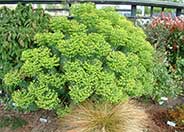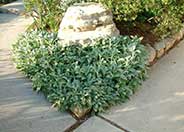
Common name:Wulfen Euphorbia
Botanical name:Euphorbia characias wulfenii
This perennial will reach about 4' tall and has significant green leaves with clusters of yellow flowers.

Common name:Dusty Miller, Silver Groundsel
Botanical name:Senecio cineraria
The Dusty Miller exhibits growth to 1' or more, with velvet gray leaves that have broad, roundish lobes. Yellow flower heads appear through the middle of the plant during most months of the year. Cut heads back occasionally to encourage bushiness.

Common name:Blue Fescue
Botanical name:Festuca glauca
This ground cover/grass will grow less than 1' tall and has small, blue green leaves.
Maintenance Tips
Festuca glauca is a perennial clump-forming grass. It has soft straw-like leaves that form a blue-green dome that can get up to about 10 inches wide and tall. They prefer full sun and well-drained soil, but can tolerate slight shade, drought conditions, and poor soil nutrition. These will send out flower stalks in the summer, which should be cut back to the base after a few months to give them a cleaner appearance. They will also benefit from having any dead leaves pulled from the plant at any time of year, but the fall is typically the best time to clean up the foliage. It is short-lived in the landscape, with a lifespan of about 2-4 years after which it dies out in the center. Some might dig up and divide the living edges into several new plants, but most of the time it is easier to replace with a new one.
Common name:Mexican Bush Sage
Botanical name:Salvia leucantha
The Mexican Sage is a bushy shrub that grows 3'-4' tall and wide. It has hairy white stems, gray green leaves and velvet-like purple flower spikes that bloom summer through fall. This shrub tolerates sun, light shade, little water, and is hardy to 15 degrees F. The Mexican Sage is drought tolerant and attracts hummingbirds.

Common name:Western Redbud
Botanical name:Cercis occidentalis
This deciduous shrub or small tree ranges from 6'-10' tall and wide. It is desirable for its magenta spring flowers, yellow to red fall color, and dangling winter seed pods. It is tolerant of many soil types, drought and oak root fungus. It attracts hummingbirds and butterflies. The Western Redbud can be found statewide in CA in the foothills below 4500' elevations in chaparral and woodland communities.
Maintenance Tips
Cercis occidentalis is a very popular California native deciduous tree. The natural form of this plant is that of a multi-branching shrub; however, it is often shaped to be a single trunk so it can be used in many garden spaces. The best way to keep the maintenance low with this tree is to plant it in a sunny location that has well-drained soil and give it the room it needs to reach its mature size. It is fairly pest and disease-resistant and performs very well as a specimen tree in native gardens. The pruning recommendations will depend on the shape of the specimen. If the tree has the multi-trunk, shrub form, the mature height can be 6-10' tall and wide and will naturally grow into a round, compact form. These forms benefit greatly from the thinning method, removing cross-branching or the longer branches to manage the plant's size. The cuts should be made towards the center of the plant, allowing sunlight into the interior. The single trunk form should be pruned the same way, but it will mature much larger and eventually should be pruned by a licensed arborist. Both forms will lose their leaves in the winter, so this is usually the easiest time to prune since the foliage is out of the way.
Common name:Lamb's Ears
Botanical name:Stachys byzantina
This tiny, herbaceous perennial will grow less than 1' tall and has medium sized, grayish green leaves with blue and lavender flowers that bloom in the spring.
Maintenance Tips
Stachys byzantina is a perennial with extremely soft, thick, fuzzy silver leaves. It has a mounding growth habit and grows about 6” tall with a spread of about 12” wide. It is a very low-maintenance plant. Old leaves near the bottom of the plant will fade and can be removed to give the plant a neater appearance. It will send out flowers on stalks in the spring that will last until summer. Once they have finished blooming, stalks should be cut off at the base where they attach to the foliage. They are susceptible to over-watering and have a lifespan of about 2-4 years in the garden, after which they can be divided into new plants or replaced with new ones.
Photographer: GardenSoft